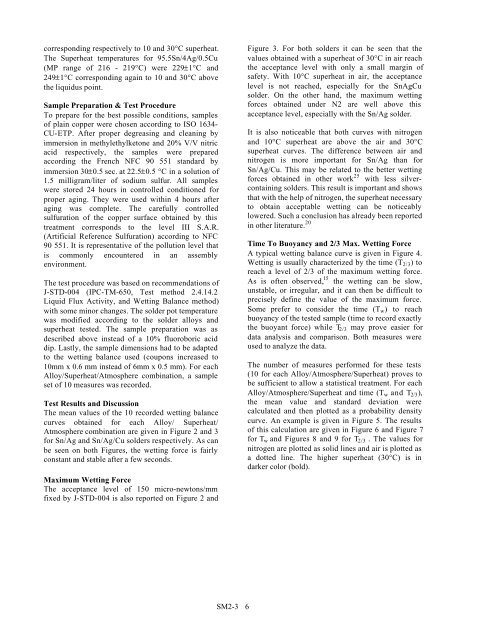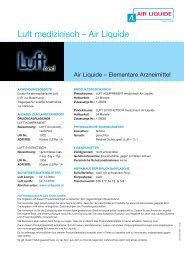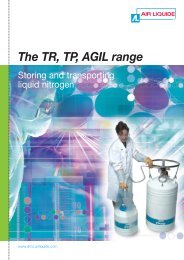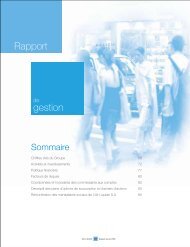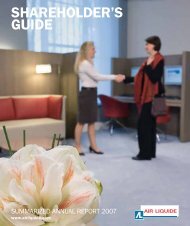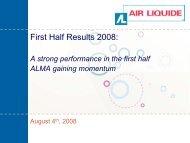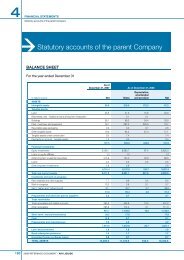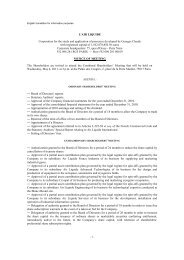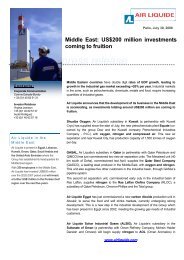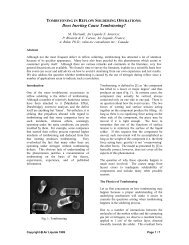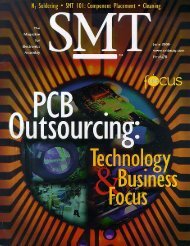Inert Soldering With Lead-Free Alloys: Review and Evaluation
Inert Soldering With Lead-Free Alloys: Review and Evaluation
Inert Soldering With Lead-Free Alloys: Review and Evaluation
Create successful ePaper yourself
Turn your PDF publications into a flip-book with our unique Google optimized e-Paper software.
corresponding respectively to 10 <strong>and</strong> 30°C superheat.<br />
The Superheat temperatures for 95.5Sn/4Ag/0.5Cu<br />
(MP range of 216 - 219°C) were 229±1°C <strong>and</strong><br />
249±1°C corresponding again to 10 <strong>and</strong> 30°C above<br />
the liquidus point.<br />
Sample Preparation & Test Procedure<br />
To prepare for the best possible conditions, samples<br />
of plain copper were chosen according to ISO 1634-<br />
CU-ETP. After proper degreasing <strong>and</strong> cleaning by<br />
immersion in methylethylketone <strong>and</strong> 20% V/V nitric<br />
acid respectively, the samples were prepared<br />
according the French NFC 90 551 st<strong>and</strong>ard by<br />
immersion 30±0.5 sec. at 22.5±0.5 °C in a solution of<br />
1.5 milligram/liter of sodium sulfur. All samples<br />
were stored 24 hours in controlled conditioned for<br />
proper aging. They were used within 4 hours after<br />
aging was complete. The carefully controlled<br />
sulfuration of the copper surface obtained by this<br />
treatment corresponds to the level III S.A.R.<br />
(Artificial Reference Sulfuration) according to NFC<br />
90 551. It is representative of the pollution level that<br />
is commonly encountered in an assembly<br />
environment.<br />
The test procedure was based on recommendations of<br />
J-STD-004 (IPC-TM-650, Test method 2.4.14.2<br />
Liquid Flux Activity, <strong>and</strong> Wetting Balance method)<br />
with some minor changes. The solder pot temperature<br />
was modified according to the solder alloys <strong>and</strong><br />
superheat tested. The sample preparation was as<br />
described above instead of a 10% fluoroboric acid<br />
dip. Lastly, the sample dimensions had to be adapted<br />
to the wetting balance used (coupons increased to<br />
10mm x 0.6 mm instead of 6mm x 0.5 mm). For each<br />
Alloy/Superheat/Atmosphere combination, a sample<br />
set of 10 measures was recorded.<br />
Test Results <strong>and</strong> Discussion<br />
The mean values of the 10 recorded wetting balance<br />
curves obtained for each Alloy/ Superheat/<br />
Atmosphere combination are given in Figure 2 <strong>and</strong> 3<br />
for Sn/Ag <strong>and</strong> Sn/Ag/Cu solders respectively. As can<br />
be seen on both Figures, the wetting force is fairly<br />
constant <strong>and</strong> stable after a few seconds.<br />
Maximum Wetting Force<br />
The acceptance level of 150 micro-newtons/mm<br />
fixed by J-STD-004 is also reported on Figure 2 <strong>and</strong><br />
SM2-3 6<br />
Figure 3. For both solders it can be seen that the<br />
values obtained with a superheat of 30°C in air reach<br />
the acceptance level with only a small margin of<br />
safety. <strong>With</strong> 10°C superheat in air, the acceptance<br />
level is not reached, especially for the SnAgCu<br />
solder. On the other h<strong>and</strong>, the maximum wetting<br />
forces obtained under N2 are well above this<br />
acceptance level, especially with the Sn/Ag solder.<br />
It is also noticeable that both curves with nitrogen<br />
<strong>and</strong> 10°C superheat are above the air <strong>and</strong> 30°C<br />
superheat curves. The difference between air <strong>and</strong><br />
nitrogen is more important for Sn/Ag than for<br />
Sn/Ag/Cu. This may be related to the better wetting<br />
forces obtained in other work 25 with less silvercontaining<br />
solders. This result is important <strong>and</strong> shows<br />
that with the help of nitrogen, the superheat necessary<br />
to obtain acceptable wetting can be noticeably<br />
lowered. Such a conclusion has already been reported<br />
in other literature. 20<br />
Time To Buoyancy <strong>and</strong> 2/3 Max. Wetting Force<br />
A typical wetting balance curve is given in Figure 4.<br />
Wetting is usually characterized by the time (T2/3) to<br />
reach a level of 2/3 of the maximum wetting force.<br />
As is often observed, 15 the wetting can be slow,<br />
unstable, or irregular, <strong>and</strong> it can then be difficult to<br />
precisely define the value of the maximum force.<br />
Some prefer to consider the time (Tw) to reach<br />
buoyancy of the tested sample (time to record exactly<br />
the buoyant force) while T2/3 may prove easier for<br />
data analysis <strong>and</strong> comparison. Both measures were<br />
used to analyze the data.<br />
The number of measures performed for these tests<br />
(10 for each Alloy/Atmosphere/Superheat) proves to<br />
be sufficient to allow a statistical treatment. For each<br />
Alloy/Atmosphere/Superheat <strong>and</strong> time (Tw <strong>and</strong> T2/3),<br />
the mean value <strong>and</strong> st<strong>and</strong>ard deviation were<br />
calculated <strong>and</strong> then plotted as a probability density<br />
curve. An example is given in Figure 5. The results<br />
of this calculation are given in Figure 6 <strong>and</strong> Figure 7<br />
for Tw <strong>and</strong> Figures 8 <strong>and</strong> 9 for T2/3 . The values for<br />
nitrogen are plotted as solid lines <strong>and</strong> air is plotted as<br />
a dotted line. The higher superheat (30°C) is in<br />
darker color (bold).


